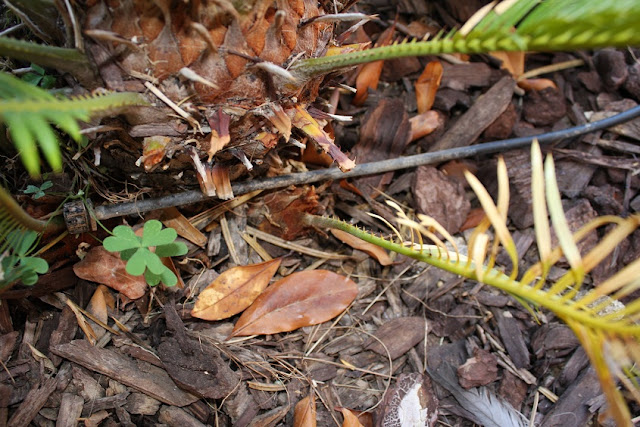Specimen 1, Cycas revoluta
The youngest of the three shown. This is planted in a total shade area and in horrific soil. Actually all of the soil in this area is hard clay and is horrible for growing Cycads and Palms. One must dig deep and wide and replace much of the natural soil with very well draining nutrient rich sandy media. Regardless of how bad the environment is, Cycas revoluta will do fine. This plant also sits at deep area of the yard which allows for too much water for the plant.
The worst aspect of this plant is the fact that it has been damaged badly at the edge of the grass by unscrupulent gardeners and their edger. I have owned this plant for five years and grew it to this size in a pot. This specimen has always been grown in shade.
Specimen 2, Cycas revoluta
This is the second to oldest specimen I have. The plant grows in full sun and sits in ideal soil that just so happened to be created during the construction of the pool. The soil is very sandy and drains quite well next to the subterranean walls of the pool. This specimen has shot 3 new leaf sets this summer and is growing quite quickly.
The newest set of leaves can be seen at the top of the plant and are a lighter green than the others. They are also still fine to the touch and have yet to harden. The new set began to sprout roughly a month ago.
Below you can see how the Cycad grows. From the top of the Caudex or wood covered ball that is the base of the plant, the leaves will sprout as a set and unravel like yard of string rolled across the floor. These leaves will eventually be pushed outwards and then point down as new sets emerge. The Caudex will eventually grow upwards as well rather than just expanding, thus forming "a trunk". This does not happen for many years.
Specimen 3, Cycas revoluta
This specimen receives nearly all day sun but sits in a low point of the yard and thus receives too much water. This along with over fertilization due to this pooling effect has caused yellowing of the leaves. This specimen also has a brand new set of leaves, roughly two weeks old.
A close up of the new set of leaves having just finished sprouting.
Here is a better shot of the Caudex, the wood ball base that expands as a ball until eventually it begins to grow upward at roughly a decade in age.
Eventually a Cycad can reproduce one of two ways. A mature Cycad can grow a cone and create seeds. There are female and male types and the male must pollinate the seeds of the female. The other type of reproduction is through basal suckers as seen below. A small offset plant will being to form at the base of the caudex and eventually grow just as the parent plant does. These can be cut away and transplanted elsewhere. Below you can see a set of leaves emerging from an offset that is still subterranean, thus its caudex is hidden. This specimen has another offset on the opposite side that is also still subterranean.
Lastly this specimen has an additional offset that is no longer subterranean and therefore has a visible caudex that was formed from the parent plant. This suckling has only one leaf and it is in very poor shape. Due to the position and orientation of the small caudex, I am guessing that is experiencing some wrought due to water soaking the top of the caudex.









No comments:
Post a Comment